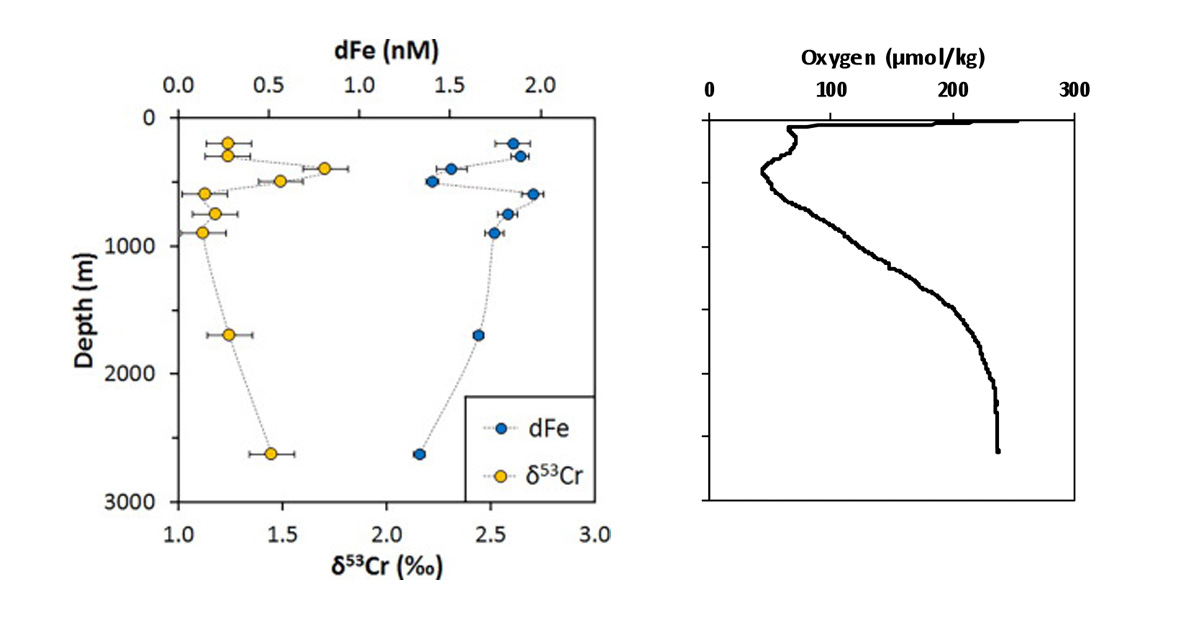Isotopic chromium variations do not always reflect the occurrence of low oxygenated waters
Dissolved chromium (Cr) in the ocean is present under two oxidation states: The oxidized and soluble Cr (VI) and the reduced more reactive Cr (III). Reduction of Cr (VI) to Cr (III) is favored by the occurrence of biological particles, reducing conditions in the sediments or the water column (at least in the Pacific Oxygen Minimum Zones). In addition, the isotopic signature of Cr (δ53Cr representing the variation of the abundance of 53Cr relative to the lighter 52Cr) also reflects redox reactions in the water column. Based on the analyses of Cr speciation and isotopic composition of 5 profiles sampled off the Senegalese coast along the GEOTRACES transect GA06, Goring-Harford and co-workers (2018, see reference below) show that Cr(VI) is unlikely to be reduced under the low oxic conditions characterizing this area (minimal values above 44 µmol/kg). Contrastingly, they reveal that total Cr concentrations and δ53Cr are affected by biological processes and inputs from sediments on the shelf whereas deep waters are relatively unaffected by internal Cr cycling. Moreover, the authors establish that on a world basis, δ53Cr is independent from the concentration of dissolved oxygen, at least for the oxygen ranges as encountered off the Senegalese coast. This result weakens the use of δ53Cr values of ancient marine authigenic precipitates to reconstruct past changes in levels of dissolved oxygen in seawater.

Figure 1: δ53Cr, dFe and dissolved oxygen profiles on one of the stations sampled. Low oxygen concentrations correlate with relatively high dFe concentrations, which are linked to high rates of organic matter remineralisation and high δ53Cr values, related to benthic supply of Cr (Adapted from Goring-Harford et al., 2018, by J. Klar).
Dissolved iron (dFe) and iron (Fe) isotopes were also collected off the same Senegalese coast as the Cr study above contributing to identify the processes leading to enhanced dFe concentrations (up to 2 nM) in the tropical North Atlantic Oxygen Minimum Zone. Negative δ56Fe values observed on the shelf could be attributed to input of dFe from both reductive and non-reductive dissolution of sediments. Contrastingly, when these benthic inputs are upwelled to surface waters, uptaken by the biological activity and remineralized in the twilight zone, they display high and positive δ56Fe and the proportion of this remineralized Fe to the total dFe pool increases with distance from the shelf. The difference of sensitivity to redox conditions between Cr and Fe isotopes is also underlined by this work. Thanks to the simultaneous aluminium concentrations, the authors also demonstrate that dust inputs were low at the time of the GEOTRACES GA06 section, strengthening the relative role of the benthic flux in the context of this study, although located next to the Saharan desert.

Figure 2: δ53Cr and dFe profiles on one of the stations sampled (Adapted from Goring-Harford et al., 2018), B) Schematic interpretation of the Fe cycle in the study area. Shelf sediments supply dFe with a light isotopic composition (↓ δ56Fe) to bottom waters. dFe is supplied to the surface mixed layer (SML) by atmospheric dust deposition and upwelled bottom waters, where phytoplankton takes up dFe with a relatively heavy isotopic composition (↑ δ56Fe). Remineralisation of sinking organic material leads to the release of dFe with a relatively heavy isotopic composition, which is mixed with benthic dFe inputs and upwelled to the SML, where it is mixed with atmospheric dFe inputs. The flux of benthic dFe decreases with distance from the coast. The continuous recycling of dFe by biological uptake and remineralisation leads to increasingly heavy isotopic compositions of dFe in the water column with distance from the shelf. Atmospheric dust inputs (fluxes in μmol dFe m−2 d−1, in brown) to the SML, calculated from dAl concentrations, were low at the time of sampling but are potentially higher at other times of the year (Croot et al., 2004). Fluxes of vertical transport to the SML (white) and horizontal transport between the bottom of the SML and 500 m depth (yellow) are from Milne et al. (2017) and are in μmol dFe m−2 d−1 (Reprinted from Klar et al., 2018). Click here to view the figure larger.
Reference:
Goring-Harford, H. J., Klar, J. K., Pearce, C. R., Connelly, D. P., Achterberg, E. P., & James, R. H. (2018). Behaviour of chromium isotopes in the eastern sub-tropical Atlantic Oxygen Minimum Zone. Geochimica et Cosmochimica Acta, 236, 41–59. https://doi.org/10.1016/j.gca.2018.03.004
Klar, J. K., Schlosser, C., Milton, J. A., Woodward, E. M. S., Lacan, F., Parkinson, I. J., Achterberg, E.P., James, R. H. (2018). Sources of dissolved iron to oxygen minimum zone waters on the Senegalese continental margin in the tropical North Atlantic Ocean: Insights from iron isotopes. Geochimica et Cosmochimica Acta, 236, 60–78. https://doi.org/10.1016/j.gca.2018.02.031
Croot, P. L., Streu, P., Baker A.R. (2004) Short residence time for iron in surface seawater impacted by atmospheric dry deposition from Saharan dust events, Geophys. Res. Lett., 31 (2004), p. L23S08 https://doi.org/10.1029/2004GL020153
Milne, A., Schlosser, C., Wake, B.D., Achterberg, E.P., Chance, R., Baker, A.R., Forryan, A., Lohan, M.C. (2017) Particulate phases are key in controlling dissolved iron concentrations in the (sub)tropical North Atlantic Geophys. Res. Lett., 44, pp. 2377-238 https://doi.org/10.1002/2016GL072314
